
A banana is an elongated, edible fruit – botanically a berry – produced by several kinds of large herbaceous flowering plants in the genus Musa. In some countries, bananas used for cooking may be called "plantains", distinguishing them from dessert bananas. The fruit is variable in size, color, and firmness, but is usually elongated and curved, with soft flesh rich in starch covered with a rind, which may be green, yellow, red, purple, or brown when ripe. The fruits grow upward in clusters near the top of the plant. Almost all modern edible seedless (parthenocarp) bananas come from two wild species – Musa acuminata and Musa balbisiana. The scientific names of most cultivated bananas are Musa acuminata, Musa balbisiana, and Musa × paradisiaca for the hybrid Musa acuminata × M. balbisiana, depending on their genomic constitution. The old scientific name for this hybrid, Musa sapientum, is no longer used.

Mount Sinai, traditionally known as Jabal Musa, is a mountain on the Sinai Peninsula of Egypt. It is possibly the same location as the biblical Mount Sinai, the place where, according to the Bible and the Quran, Moses received the Ten Commandments.
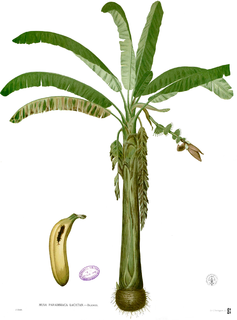
Musaceae is a family of flowering plants composed of three genera with about 91 known species, placed in the order Zingiberales. The family is native to the tropics of Africa and Asia. The plants have a large herbaceous growth habit with leaves with overlapping basal sheaths that form a pseudostem making some members appear to be woody trees. In most treatments, the family has three genera, Musella, Musa and Ensete. Cultivated bananas are commercially important members of the family, and many others are grown as ornamental plants.

Musa I, or Mansa Musa, was the ninth Mansa of the Mali Empire, one of the most powerful West African states. He has sometimes been called the wealthiest person in history, though his wealth is impossible to accurately quantify and it is difficult to meaningfully compare the wealth of historical figures.

In Islam, Mūsā ibn ʿImrān, is an important prophet and messenger of God (Allah) and is the most frequently mentioned individual in the Quran, with his name being mentioned 136 times and his life being narrated and recounted more than that of any other prophet.

Musa is one of two or three genera in the family Musaceae. The genus includes flowering plants producing edible bananas and plantains. Around 70 species of Musa are known, with a broad variety of uses.

Cornus sanguinea, the common dogwood or bloody dogwood, is a species of dogwood native to most of Europe and western Asia, from England and central Scotland east to the Caspian Sea. It is widely grown as an ornamental plant.
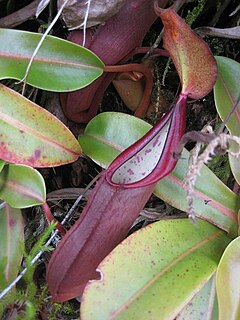
Nepenthes sanguinea is a large and vigorous Nepenthes pitcher plant species, native to Peninsular Malaysia and southernmost Thailand, where it grows at 300–1800 metres altitude. The pitchers are variable in size, from 10–30 cm tall, and range from green and yellow to orange and red. The insides of the pitchers are usually speckled with its two main colors. It was introduced to Victorian Britain around 1847 by Cornish plant hunter and botanist Thomas Lobb via the Veitch Nurseries.
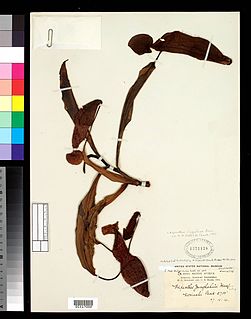
Nepenthes junghuhnii is a tropical pitcher plant native to Sumatra. This species has been the source of much confusion since its discovery. The taxon originally named N. junghuhnii by John Muirhead Macfarlane has never been formally published. In 1994, taxonomist Jan Schlauer described N. junghuhnii as a "rather dubious species based on insufficient specimens". Nepenthes junghuhniisensu Macfarlane has not been relocated in the wild since the collection of the type specimen. It is characterised by strongly petiolate leaves and appears to be most closely related to N. bongso and N. spathulata; Schlauer considers it a possible synonym of the former.

Formica sanguinea, or blood-red ant, is a species of facultative slave-maker ant in the genus Formica characterized by the ability to secrete formic acid. It ranges from Central and Northern Europe through Russia to Japan, China, the Korean Peninsula, Africa and also the United States. This species is coloured red and black with workers up to 7 mm long.
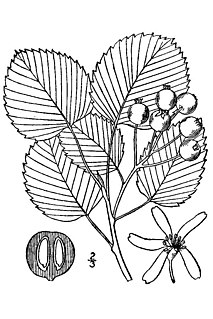
Amelanchier sanguinea, known as red-twigged shadbush or roundleaf serviceberry, is a shrub native to eastern and central North America. Its native range stretches from New Brunswick to Saskatchewan south as far as northern Georgia. It is most common in eastern Canada, the northeastern United States, and the Great Lakes region.
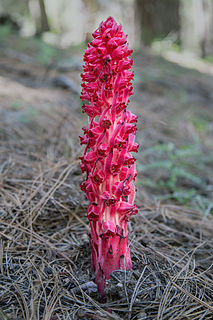
Sarcodes is the monotypic genus of a north-west American flowering springtime plant in the heath family (Ericaceae), containing the single species Sarcodes sanguinea, commonly called the snow plant or snow flower. It is a parasitic plant that derives sustenance and nutrients from mycorrhizal fungi that attach to tree roots. Lacking chlorophyll, it is unable to photosynthesize. Ectomycorrhizal (EM) symbioses involve a mutualism between a plant root and a fungus; the plant provides fixed carbon to the fungus and in return, the fungus provides mineral nutrients, water, and protection from pathogens to the plant. The snow plant takes advantage of this mutualism by tapping into the network and stealing sugars from the photosynthetic partner by way of the fungus. This is known as mycoheterotrophy. The snow plant is host-specific and can only form relationships with the ectomycorrhizal Basidiomycete Rhizopogon ellenae.

Oroxindin is a flavone, a type of phenolic chemical compound. It is a wogonoside, more accurately a wogonin glucuronide isolated from Oroxylum indicum (Bignoniaceae), Bacopa monnieri (Plantaginaceae) and Holmskioldia sanguinea.

Ahmed Musa is a Nigerian professional footballer who plays as a forward and left winger for Turkish Süper Lig club Fatih Karagümrük and the Nigeria national team.

Akashiwo sanguinea is a species of marine dinoflagellates well known for forming blooms that result in red tides. The organism is unarmored (naked). Therefore, it lacks a thick cellulose wall, the theca, common in other genera of dinoflagellates. Reproduction of the phytoplankton species is primarily asexual.

Telipna sanguinea, the sanguine telipna, is a butterfly in the family Lycaenidae. It is found in Nigeria, Cameroon, the Republic of the Congo, Equatorial Guinea, Gabon, Angola, the Central African Republic, the Democratic Republic of the Congo, Uganda and Tanzania. The habitat consists of forests.

The siege of Constantinople of 1411 occurred during the Ottoman Interregnum, or Ottoman Civil War,, when chaos reigned in the Ottoman Empire following the defeat of Sultan Bayezid I by the Central Asian warlord Timur. Although Mehmed Çelebi was confirmed as sultan by Timur after the Battle of Ankara, his brothers İsa Çelebi, Musa Çelebi, Süleyman Çelebi, and later, Mustafa Çelebi, refused to recognize his authority, each claiming the throne for himself. A civil war was the result. The Interregnum lasted until the Battle of Camurlu on 5 July 1413, when Mehmed Çelebi emerged as victor in the strife, crowned himself sultan Mehmed I, and restored peace to the empire.

Iris sanguinea is a rhizomatous flowering plant in the genus Iris and in the series Sibiricae. It is cultivated as an ornamental plant in temperate regions. It is one of the species considered a Japanese iris. It is from Asia, found between Russia, Mongolia, China, Japan and Korea. It has grey green leaves, an unbranched flowering stem and flowers in reddish-purple shades, from blue to blue-purple, red-violet, with a rare white variant.
Hyblaea sanguinea is a moth in the family Hyblaeidae described by Max Gaede in 1917.
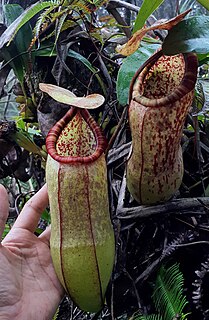
Nepenthes malayensis, or the striped Malayan montane pitcher plant, is a large species of carnivorous tropical pitcher plant native and endemic to eastern mountains of Peninsular Malaysia. The peristomes on both upper and lower pitchers are profusely adorned by reddish bands, or stripes, making the species rather attractive. It grows close to mountain summits around 800–1000 m above sea level in partially shaded areas, though some individuals have been seen striving in open areas. The species was first observed in 2018 and initially thought to be conspecific with N. sanguinea. Nepenthes malayensis' formal description was published in late 2020 in Kew Bulletin and it is one of the latest three new Malayan species described in the same year. These discoveries have made Peninsular Malaysia home to 15 species of Nepenthes and there are over 150 species of world's Nepenthes with the majority of these are from the Malay Archipelago.


















